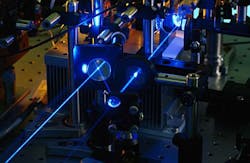Lockheed Martin Aculight to develop 60-kilowatt laser to kill UAVs, rockets, and mortars
HUNTSVILLE, Ala., 4 Sept. 2013.laser weapons experts at Lockheed Martin Aculight on Bothell, Wash., will help the U.S. Army develop a 60-kilowatt fiber laser module for a truck-mounted laser weapon system intended to shoot down enemy unmanned aerial vehicles (UAVs), rockets, artillery rounds, and mortars.
Officials of the Army Space and Missile Defense Command in Huntsville, Ala., announced their intention last week to award a sole-source contract to Aculight to develop the 60-kilowatt laser module for integration with the High Energy Laser Mobile Demonstrator (HEL MD) -- a joint project of the Army and the Boeing Co. Directed Energy Systems segment in St. Louis.
The upcoming contract will ask Aculight experts to capitalize on technology developed under the U.S. military's Robust Electric Laser Initiative (RELI) such that they can increase laser weapons power from the 25 kilowatts demonstrated in the RELI program to 60 kilowatts. The HEL MD program is intended to develop a laser weapon to counter airborne threats with lasers of 50 to 100 kilowatts.
Under terms of the upcoming contract, Aculight will build and integrate additional RELI 2-kilowatt fiber laser modules identical to those required for the RELI 25-kilowatt laboratory laser, to reach 60 kilowatts output power, Army officials explain.
Aculight experts also will characterize the RELI beam combining fiber array and spectral beam combiner for the higher thermal loading imposed by the increased power.
This 60-kilowatt laser will be integrated into the HEL MD to support an upcoming demonstration. Although the value of the contract has not been finalized, Army officials say they estimate it will be worth $23.8 million over three years.
This project is a continuation of a succession of laser weapons research programs to ratchet-up the power of laser beams to make them strong enough for future generations of laser weapons.
The RELI project builds on laser weapons technologies developed earlier in the Joint High Power Solid State Laser (JHPSSL) and the High Energy Liquid Laser Area Defense System (HELLADS) programs. RELI was a follow-on project intended to capitalize on technologies developed in JHPSSL and HELLADS.
The JHPSSL and HELLADS projects developed technologies for packaging, cooling, and fire-control capability for future laser weapons. The RELI program has focused on drastic improvements in laser efficiencies, as well as in packaging small enough for deployable laser weapons on tactical aircraft and vehicles.
The RELI program involves Raytheon Space Systems in El Segundo, Calif.; the Boeing Directed Energy Program in Albuquerque N.M., and Lockheed Martin Aculight. Partners on the RELI program are the Army and U.S. Air Force. The U.S. Navy also is expected to get involved.
For more information contact Lockheed Martin Aculight at www.lockheedmartin.com/us/products/aculight.

